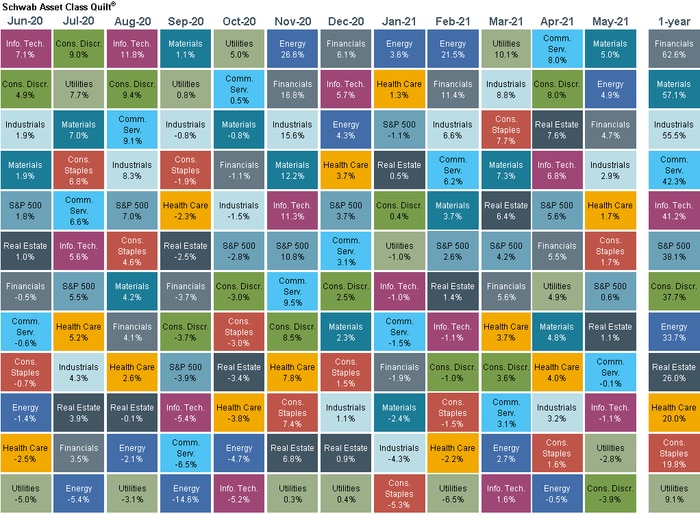We’re almost to the midway point of 2021, and what an interesting first half of the year it’s been:
* Thankfully, the economy continues to reopen as more and more people receive their COVID vaccinations.
* Demand continues to outstrip supply for many goods and services, which is leading to higher prices.
* Travel has picked up as people resume their lives, and home prices continue to soar — along with construction costs.
* Meme stocks and cryptocurrency continue to dominate the financial news.
* Interest rates remain near zero, while the 10-year Treasury remains close to 1.5%.
The S&P 500 (stock market) momentum continues to be positive, led by financials and energy, as investors currently favor value over growth. The chart below reflects the different sectors that comprise the S&P 500 over the last year. Energy, Materials and Information Technology are the only sectors that have been the best-performing sector for more than one month. Financials have had the strongest 12-month return but led the S&P sectors in only one month (December).

We are reallocating and rebalancing the portfolios and making the following changes for the second half of 2021:
1. We are reducing our exposure in healthcare to a market-weight level from an overweight position. We continue to believe strongly in the healthcare sector for the long term, thanks especially to new innovations, as we saw last year with the rapid production of the COVID vaccine and recent approval of an Alzheimer’s drug.
2. Financial stocks remain inexpensive on a price-to-earnings multiple basis, and we are adding additional exposure to the asset class. We believe that small stocks will continue to benefit from the economic reopening, and we are increasing our current allocation. With both moves, we continue to balance growth and value in the portfolio.
3. From a fixed-income perspective, we are further reducing our current weighting in high-quality corporate bonds and adding to our strategic income fund that provides diversification to different asset classes within fixed income. As interest rates rise, certain segments within fixed income invest in bonds that rise with higher rates and provide increased flexibility within the portfolio.
Our focus remains on long-term investing with a strategic allocation while maintaining a tactical approach. Our decisions to make changes are calculated and well thought-out, looking at where we see the economy heading. We are not guessing or market timing. We are anticipating and moving to those areas of strength in the economy — and in the stock market. We strategically have new cash on the sidelines and buy in for those clients on down days or dips in the market, like one does through a 401K every other week. We speak with our clients regularly about staying the course and not listening to the economic noise and trading meme stocks.
In the short term, the outlook for the global economy looks strong. The Federal Reserve bank has reiterated that it plans to allow inflation to increase for the foreseeable future and is unlikely to raise short-term interest rates in the near future. The Fed also is closely watching employment numbers and adjusting the money flow and bond purchases based on job reports.
So, what can we learn from all this? We continue to adhere to the tried-and-true disciplines of diversification, periodic rebalancing and looking forward, while not making investment decisions based on where we have been. Making market decisions based on what might happen may be detrimental to long-term performance. The key is to stay invested and stick with the financial plan. Markets go up and down over time, and downturns present opportunities to purchase stocks at a lower value.
It all starts with a solid financial plan for the long run that understands the level of risk that is acceptable for each client. Regarding investments, we believe in diversification and having different asset classes that allow you to stay invested. The best option is to stick with a broadly diversified portfolio that can help you to achieve your own specific financial goals — regardless of market volatility. Long-term fundamentals are what matter.
Source: Schwab
This material contains an assessment of the market and economic environment at a specific point in time and is not intended to be a forecast of future events, or a guarantee of future results. Forward-looking statements are subject to certain risks and uncertainties. Actual results, performance, or achievements may differ materially from those expressed or implied. Information is based on data gathered from what we believe are reliable sources.
Using diversification as part of your investment strategy neither assures nor guarantees better performance and cannot protect against loss of principal due to changing market conditions.
Past performance is not a guarantee of future results.
The opinions expressed in this commentary are those of the author and may not necessarily reflect those held by Kestra Investment Services, LLC or Kestra Advisory Services, LLC. This is for general information only and is not intended to provide specific investment advice or recommendations for any individual. It is suggested that you consult your financial professional, attorney, or tax advisor with regard to your individual situation.
Securities offered through Kestra Investment Services, LLC (Kestra IS), member FINRA/SIPC. Investment Advisory Services offered through Kestra Advisory Services, LLC (Kestra AS) an affiliate of Kestra IS. Kestra IS and Kestra AS are not affiliated with CD Wealth Management. Investor Disclosures: https://bit.ly/KF-Disclosures





